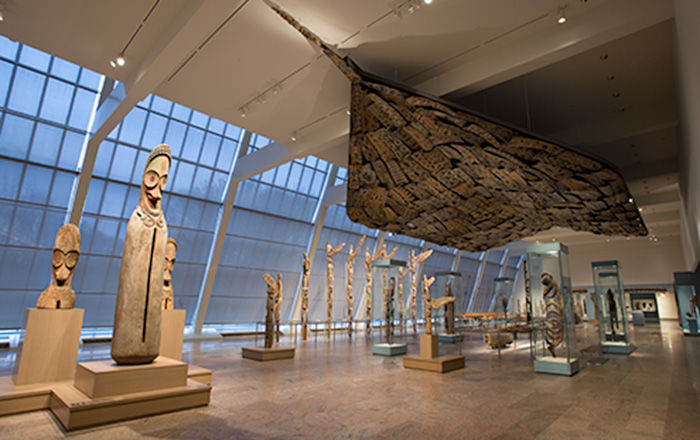Akua 'ba figure
Not on view
The name akua ‘ba (literally, Akua’s child) derives from an Akan legend about a woman named Akua who struggled with infertility. To address her condition, she consulted a priest who advised her to commission the carving of a small wooden child and care for it as she would a living baby, including nursing it and putting it to bed. Despite facing public ridicule with members of her community mockingly calling the figure “akua ‘ba,” her care and dedication to the figure led to a successful pregnancy and the birth of her daughter, which inspired other women to craft similar figurines. Along with conception, the akua ‘maa (plural) may be prescribed by a priest to prevent complications during pregnancy and childbirth and to avert disease so that the mother and child remain healthy.
The style of this example relates to akua ‘maa carved among the Asante, the ruling federation of the Akan. Distinctive features include an elongated forehead on a round head; thin nose; sweeping, arched eyebrows; small, pursed lips; a ringed neck; and large eyes that are identified by narrow slits that slightly protrude from the surface. These features emphasize the feminine ideal for which physical and moral beauty were closely intertwined. For example, wisdom is emphasized through the elongated forehead, and wealth and nourishment depicted through the ringed neck of a well-fed individual. Women would give their akua ‘maa these characteristics in the hope that their daughter would inherit them.
Many akua ‘maa might feature additional adornments in the forms of applied beadwork and other attachments. This example has a string of red beads hanging loosely around its neck. Prior to the late twentieth century, akua ‘maa were one of the most personal items and the kind of beads used to adorn them could help indicate the owner’s religious affiliation, taste, and wealth. The specific use of red may have been a personal choice by the owner, or they could have been used due to red’s symbolic association with women through Asase Ya, the goddess of the earth and fertility, who has the power to bring life and wealth, as well as cause suffering in the pursuit of it. Red is also associated with blood and life and therefore reproduction among Akan herbalists, which is why red clay is used for treatments regarding fertility.
While most Asante akua ‘ba are painted a glossy black color, this figurine stands out for its light brown hue. Akua ‘maa are traditionally painted black because of the color’s association with time, death, reincarnation, and ancestral power. Among the Akan, children are understood to exist as spirits in asamando (the land of the ancestors) before they enter awiase (the physical world). The use of black on akua ‘maa encourages a child to venture from the ancestral realm to that of the living. Funerary figures are similarly painted black to ease the transition back from the awiase to asamando.
The akua ‘ba is attached to a small, darker-hued square base, indicative of its transition from a context of maternal care to its display within art contexts. Since at least the 1950s, akua ‘maa have been sold commercially by former owners and by professional sculptors in Ghana as art objects, souvenirs, and toy dolls. That commercial demand has inspired artists to improvise with traditional styles by adding, subtracting, exaggerating, or minimizing various components. This could explain why this akua ‘ba was not painted black. It could also have been originally painted black and subsequently scoured before being sold to sever that connection to asamando.
While many Akan women do not use commercial akua ‘maa, some may purchase them as toys for their daughters or take them to a priest so that they can be transformed into fertility tools to assist with pregnancy and childbirth. Depending on the resources available, it could be easier and less costly for a woman prescribed an akua ‘ba to acquire one from the market than to commission one.
Ellie Luchini
Roswell L. Gilpatric MuSe Intern, 2025
This image cannot be enlarged, viewed at full screen, or downloaded.
